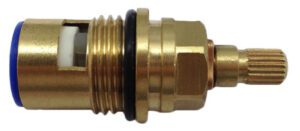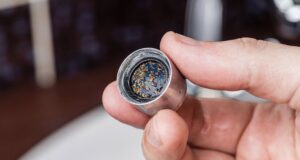Are you dealing with a shower that just won’t quit running? This common yet frustrating plumbing problem can not only lead to a skyrocketing water bill, but also cause severe water damage if not addressed promptly.
Our straightforward guide will walk you through easy-to-follow troubleshooting steps to identify and resolve this issue all by yourself! Stick around – every drop of knowledge counts!
Causes of a Shower That Won’t Turn Off
A malfunctioning shower valve, worn-out rubber washer, and sediment buildup are common causes of a shower that won’t turn off.
Malfunctioning shower valve

A malfunctioning shower valve can seriously disrupt your daily routine. A faulty shower valve may cause the water to continue pouring out, even after you’ve turned the knob off. This issue not only wastes a significant amount of water but can also lead to potential water damage in the bathroom.
The problem often lies within the control flow or temperature regulator within the valve. This could be due to mineral buildup in and around the valve or a clog that restricts its function.
You might notice these issues when you find it hard turning your shower handle, see changes in your water pressure, or even when experiencing inconsistent temperatures during showers.
Worn-out rubber washer
A worn-out rubber washer is a common culprit when your shower faucet won’t turn off. Over time, the constant water flow wears out these small, yet crucial components of your plumbing system.
As this wear and tear progress, they can lose their ability to effectively seal and control water flow.
To address this issue, you’ll first need to shut off the main water supply to avoid any unintended messes or additional water waste. Next, with the right tools at hand––typically an adjustable wrench and a screwdriver––you can carefully remove the faulty shower valve or knob that houses the worn-out washer.
Then replace it with a new one matching its size and type perfectly found in faucet repair kits usually available at local hardware stores. Remember to align everything correctly during reassembly for optimal function of your shower set after replacing the worn-out rubber washer.
Sediment buildup
Sediment buildup can lead to serious plumbing issues in your home. Minerals from hard water accumulate inside pipes and shower valves over time. This residue restricts water flow, leading to a stubborn shower that won’t turn off.
If left unchecked, the accumulated deposits could eventually cause total blockage or damage the valve completely. Regular inspection and cleaning of your faucets can prevent this problem, ensuring smooth operation of the shower handle and preventing unnecessary increase in your water bill due to a drippy faucet or continuous pour of water.
Professional plumbers often employ techniques like scrubbing with vinegar solution to dissolve mineral deposits before they escalate into bigger clogs that may require replacing parts such as rubber washers, shower cartridges or even entire assemblies.
How to Recognize a Shower That Won’t Turn Off
A shower that won’t turn off can be frustrating and lead to water wastage. To recognize this issue, pay attention to the sound of running water even when the faucet handle is in its closed position.
Additionally, check for any visible leaks around the showerhead or tub spout. Another telltale sign is if you notice that the temperature or flow of water cannot be controlled properly.
These signs indicate a malfunctioning shower valve, worn-out rubber washers, or sediment buildup within the faucet.
If you observe any of these signs in your shower, it’s important to address them promptly to avoid water damage and high bills.
Solutions for a Shower That Won’t Turn Off
To fix a shower that won’t turn off, try tightening the faucet handle or replacing the cartridge. Learn more about these solutions and other troubleshooting steps to take in our blog post.
Tightening the faucet handle

To address a shower that won’t turn off, one possible solution is to tighten the faucet handle. Over time, the handle might become loose, causing water to continue flowing even when the shower should be off.
By tightening the handle, you can restore control over the water flow and prevent any further leaks or drips. Remember to turn off your main water supply before attempting to tighten the faucet handle to avoid any unexpected water flow or accidents.
Replacing the cartridge

To fix a shower that won’t turn off, one possible solution is to replace the cartridge. The cartridge is the part inside the shower valve that controls the flow of water. Over time, it can become worn or damaged, which can lead to issues with turning off the water completely.
To replace the cartridge, you will need to turn off the main water supply and remove the handle and trim plate from your shower valve. Then, carefully remove the old cartridge and insert a new one in its place.
Finally, reassemble everything and turn on the water supply to see if the problem has been resolved.
Replacing the hot/cold assembly pieces
To fix a shower that won’t turn off, you may need to replace the hot/cold assembly pieces. Over time, these pieces can become worn or damaged, causing issues with water flow and temperature control.
To do this, start by turning off the main water supply to your shower. Then, carefully remove the handle and any screws holding the hot/cold assembly in place. Once removed, replace it with a new assembly piece and reassemble the faucet.
This should help resolve any problems with your shower not turning off properly.
Repairing a ball shower faucet
To repair a ball shower faucet, you will need to gather a few tools: an adjustable wrench, pliers, and a replacement kit for the ball faucet. Start by shutting off the water supply to your shower.
Then, remove the handle and faceplate of the faucet using your adjustable wrench and pliers. Once you have access to the cartridge assembly, carefully remove it and replace it with the new one from your replacement kit.
Reassemble everything in reverse order, making sure all connections are tight. Turn on the water supply and test your newly repaired ball shower faucet for any leaks or drips.
Common Causes of a Shower Faucet That Won’t Turn Off
Mineral buildup, installation issues, damaged parts, loose connections, and worn-out washers are some common causes of a shower faucet that won’t turn off.
Mineral buildup
Mineral buildup in your shower can cause a variety of problems, including a shower that won’t turn off. Over time, minerals from hard water can accumulate inside the shower valve, leading to blockages and malfunctions.
When this happens, it can prevent the valve from fully closing and result in continuous water flow. To resolve this issue, you’ll need to clean out the mineral deposits. Start by turning off the main water supply to your home to prevent any accidents.
Then, dismantle the affected parts of your shower faucet and use a mixture of vinegar and water or a descaling solution to dissolve the minerals. Scrub away any remaining residue with an old toothbrush or scrub brush before reassembling everything back together.
Installation issues
Installing a shower can sometimes be tricky, and if not done correctly, it can lead to issues with turning off the water. One common installation issue is improper alignment of the faucet handle.
When this happens, the handle may not fully shut off the water, causing it to continue flowing even when you try to turn it off. Another installation issue is loose connections between parts, such as the valve or pipes.
These loose connections can result in water leakage and difficulty in shutting off the shower completely. It’s important to ensure that all components are properly installed and connected to prevent these problems from occurring.
Damaged parts
If your shower won’t turn off, it could be due to damaged parts. Over time, the components of your shower can wear out or become damaged, leading to issues with shutting off the water flow.
Common damaged parts that may cause this problem include broken valve stems, worn-out seals or gaskets, and cracked pipes. When these parts are compromised, they can prevent the proper functioning of your shower’s plumbing system.
Identifying and replacing any damaged parts is crucial for resolving the issue and restoring control over your shower’s water flow.
Loose connections
Loose connections can also cause a shower that won’t turn off. Over time, the nuts and bolts that hold your shower valve together may become loose due to normal wear and tear or improper installation.
When connections are loose, water can leak out and prevent the shower from fully shutting off. If you suspect loose connections, carefully inspect the area around your shower valve for any visible signs of looseness or wobbling.
You may need to tighten these connections using an appropriate wrench or pliers to ensure a secure fit and proper function of your shower valve.
Worn-out washers
If you have a shower that won’t turn off, worn-out washers could be the culprit. Over time, the rubber washers inside your shower valve can become deteriorated and no longer create a watertight seal.
This can cause water to continuously flow, even when you try to shut off the faucet. To fix this issue, you’ll need to replace the worn-out washers with new ones. By doing so, you should be able to regain control over the water flow in your shower and prevent any further leaks or water waste.
Clogged aerator

If your shower won’t turn off, a possible cause could be a clogged aerator. Over time, mineral deposits and debris can accumulate in the aerator, blocking the flow of water and preventing the faucet from shutting off completely.
To troubleshoot this issue, start by removing the aerator from the faucet. Then, clean it thoroughly by soaking it in vinegar or using a brush to scrub away any buildup. Once cleaned, reattach the aerator to the faucet and test if the problem persists.
If it does, you may need to seek further assistance or explore other causes for your shower not turning off.
Troubleshooting Steps for a Shower That Won’t Turn Off
To troubleshoot a shower that won’t turn off, follow these steps to identify the problem and fix it quickly. Don’t let a drippy faucet become a bigger issue – read on for the solutions you need!
Identify the problem
Identifying the problem when your shower won’t turn off is the first step in troubleshooting. Start by examining the faucet handle and determining if it’s loose or difficult to turn.
If it doesn’t seem to be a handle issue, check for any leaks around the shower valve or visible water flow even when the handle is closed. Take note of any unusual sounds coming from the faucet as well.
By identifying these signs, you can narrow down potential causes and move on to finding a solution that will get your shower back in working order.
Turn off main water supply
To fix a shower that won’t turn off, the first step is to turn off the main water supply. This will prevent any further water flow and allow you to work on the problem without causing any additional damage.
Locate the shut-off valve near your water meter or in your basement and turn it clockwise to close it. By shutting off the main water supply, you can safely proceed with troubleshooting and resolving the issue with your shower.
Clean debris and mineral deposits
To troubleshoot a shower that won’t turn off, one of the steps involves cleaning debris and mineral deposits. Over time, these particles can accumulate in the shower valve or faucet, causing it to malfunction.
To clean them out, you will need to disassemble the affected parts and use a brush or toothbrush to scrub away any build-up. Then, rinse thoroughly to ensure all debris is removed.
This step helps restore proper water flow and might solve the issue of a shower that won’t shut off.
Inspect installation and parts
To troubleshoot a shower that won’t turn off, it’s important to inspect the installation and parts. Start by checking if all the components are properly installed and aligned. Look for any loose connections or damaged parts that may be causing the issue.
Additionally, examine the faucet handle and make sure it is secured tightly. If there are any signs of wear or damage, consider replacing the necessary parts to restore proper functionality.
By thoroughly inspecting the installation and parts, you can identify any potential issues that may be preventing your shower from turning off correctly.
Reassemble faucet
To reassemble the faucet, carefully follow these steps. Start by placing the handle back onto the stem and tightening any screws or bolts to secure it in place. Next, attach any decorative caps or covers that were removed during disassembly.
Then, reconnect the water supply lines and tighten them using an adjustable wrench. Finally, turn on the main water supply and test the faucet to ensure it is working properly. Take your time during this process to ensure everything is correctly aligned and tightened for a leak-free faucet operation.
When to Call a Professional for Help
If you’ve gone through the troubleshooting steps and your shower still won’t turn off, it may be time to call in a professional plumber. They have the expertise and tools to diagnose and fix any underlying issues that may be causing your shower to malfunction.
Don’t hesitate to reach out for help when needed to prevent further water damage and ensure your shower is working properly. Learn more about when to call a professional for assistance with your stubborn shower faucet here.
Final thoughts
To wrap up, troubleshooting a shower that won’t turn off can seem like a daunting task. However, by following the steps outlined in this article, you can easily identify and fix the issue yourself.
Remember to always start by turning off the main water supply before inspecting and cleaning your shower valve for any debris or mineral buildup. If these solutions don’t work, it’s best to call a professional plumber who can handle more complex repairs.
By taking prompt action, you can prevent water wastage and avoid potential water damage to your home.
Conclusion
Take control of your malfunctioning shower with these troubleshooting steps for a shower that won’t turn off. Identify the issue, turn off the main water supply, clean any debris or mineral deposits, inspect the installation and parts, then reassemble the faucet.
With these simple steps, you can get your shower back to working order and avoid water waste and potential damage. Don’t hesitate to call a professional if needed!
FAQs:
1. Why is my shower faucet continually dripping water?
Your shower faucet could be dripping due to several issues like a clogged shower valve, problems with the shower knob, or a faulty diverter valve.
2. How can I fix my drippy shower faucet myself?
You can try simple solutions like aligning the faucet handle correctly, tightening set screws or replacing seats and springs for your single knob shower valve using basic DIY plumbing techniques.
3. What steps should I take if water continues to pour after shutting off the main water supply?
If water continues to pour even after turning off the main valve shut off, you may need professional plumbing assistance for tasks involving replacement of major parts like the entire old shower set or adjusting complex systems such as water pressure control.
4. Can mineral buildup affect the temperature of water my shower releases?
Yes! Mineral buildup in places such as your showerhead could cause improper function leading to inconsistent temperature of your bathwater; giving it cleaning would help improve its performance significantly.
5. When should I opt for professional plumbing services instead of managing on my own?
When facing challenges that involve plumbing safety precautions such as dealing with high-pressure systems and major component replacements including complex procedures like old showers set removal or new showers installation, going pro is recommended.
6. Are there potential benefits that come with upgrading or replacing components within my existing Shower Set?
Absolutely! Replacing defective elements such as faucets handles, diverter valves and installing an entirely new upgraded Shower Set not only improves functionality but also contributes towards prevention aqua-wastage and potential future Plumbing Maintenance expenses.

